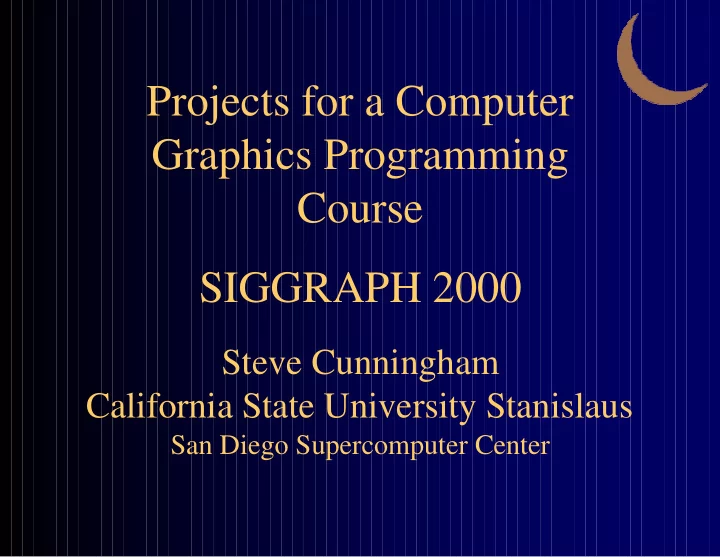

Projects for a Computer Graphics Programming Course SIGGRAPH 2000 Steve Cunningham California State University Stanislaus San Diego Supercomputer Center
The Course • Strongly API based and intended for more than computer science students • Focuses on computer graphics programming rather than graphics principles and techniques • Primary goal is to develop student skills in – working with graphics processes for modeling and rendering and – understanding visual communication for – developing effective images and interactions
One way to define projects We can design the projects for a graphics course to use the increasingly complex concepts we present in the class, and focus on the techniques that use these concepts • This is a standard approach in most courses and textbooks • The concept sequence in my programming- oriented, API-based course follows
Concept Sequence • Simple geometry with hard-coded vertices and color, with simple viewing parameters and simple motion • Simple modeling using transformations • Lighting and shading models • User interaction through callback-based control, including keyboard, mouse, and building control panels
Concept Sequence • Texture mapping – Chromadepth™ viewing • Hierarchical modeling • Features supported by the API – Clipping, LOD techniques, fog, … • Selection/picking • Evaluators
But There Are Other Ways... Only thinking about projects this way ignores a key fact about computer graphics: • The real value of computer graphics is its ability to communicate information • Students need to learn about using graphics for communication, and this is best done by experience
Our Response… • The technical content of each project is given by the content outline, but students must also make their work communicate solid concepts • My project areas focus on the sciences because of my personal interests and my relationship with his science faculty • Other areas are possible depending on the instructor and institution
To Implement This… • Students do not do pre-defined projects, but must choose the details of their projects to satisfy a problem and must write a project description that gives the context of the problem and describes how it is to be solved • Students must also write a project summary that describes how the program solves the problem and indicates what the graphics says about the problem
This approach is new… …and I cannot give a complete account of its success, but it has been generally well accepted by my students and by those to whom I’ve presented it, and should produce students who are stronger in approaching genuine problems with their graphics skills
Availability of Materials • Notes for the course are still in development and are available at – http://www.cs.csustan.edu/~rsc/NSF • Content of this page are evolving but now include examples of a number of science applications • Materials for the course as it is taught this fall will also be available through this page
Credits • This work is partially supported by National Science Foundation grant DUE-9950121. All opinions, findings, conclusions, and recommendations in this work are those of the author and do not necessarily reflect the views of the National Science Foundation. • Thanks to Mike Bailey of the San Diego Supercomputer Center for hosting me for my sabbatical and for many fruitful discussions
Demonstrations • Projects in various science areas, with different levels of technical content – Appreciation to the students from San Diego State University and California State University Stanislaus whose work is being used
Recommend
More recommend